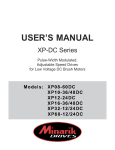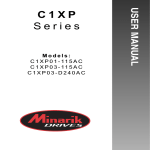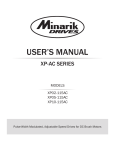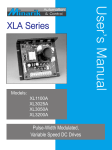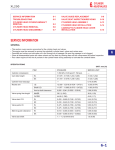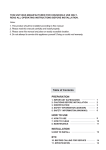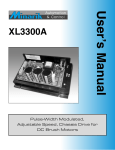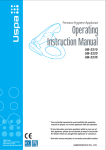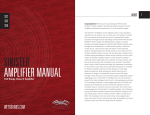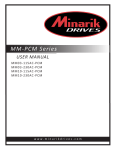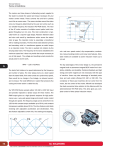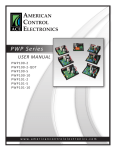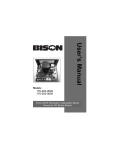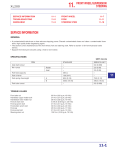Download User Manual - Galco Industrial Electronics
Transcript
USER’S MANUAL PCMXP Series Isolated Input, Pulse-Width Modulated, Adjustable Speed Drives for DC Brush Motors Models: PCMXP02–115AC PCMXP05–115AC PCMXP10–115AC Copyright © 2013 by Minarik Drives All rights reserved. No part of this document may be reproduced or transmitted in any form without written permission from Minarik Drives. The information and technical data in this document are subject to change without notice. Minarik Drives makes no warranty of any kind with respect to this material, including, but not limited to, the implied warranties of its merchantability and fitness for a given purpose. Minarik Drives assumes no responsibility for any errors that may appear in this document and makes no commitment to update or to keep current the information information in this document. Printed in the United States of America. i Safety Warnings • This symbol denotes an important safety tip or warning. Please read these sections carefully prior to performing any of the instructions contained in that section. • Have a qualified electrical maintenance technician install, adjust and service this equipment. Follow the National Electrical Code and all other applicable electrical and safety codes, including the provisions of the Occupational Safety and Health Act (OSHA), when installing equipment. • Reduce the chance of an electrical fire, shock, or explosion by proper grounding, over-current protection, thermal protection, and enclosure. Follow sound maintenance procedures. It is possible for a drive to run at full speed as a result of a component failure. Minarik strongly recommends the installation of a master switch in the main power input to stop the drive in an emergency. Circuit potentials are at 115 VAC above earth ground. Avoid direct contact with the printed circuit board or with circuit elements to prevent the risk of serious injury or fatality. Use a non-metallic screwdriver for adjusting the calibration trimpots. Use approved personal protective equipment and insulated tools if working on this drive with power applied. ii Contents Safety Warnings . . . . . . . . . . . . . . . . . . . . . . . . . . . . . . . . . . . . . . . . .i Specifications . . . . . . . . . . . . . . . . . . . . . . . . . . . . . . . . . . . . . . . . .1 Dimensions . . . . . . . . . . . . . . . . . . . . . . . . . . . . . . . . . . . . . . . . . . . .2 Installation Mounting . . . . . . . . . . . . . . . . . . . . . . . . . . . . . . . . . . . . . . . . . . . .3 . . . . . . . . . . . . . . . . . . . . . . . . . . . . . . . . . . . . . . . . . . . . . . . . .3 Wiring . . . . . . . . . . . . . . . . . . . . . . . . . . . . . . . . . . . . . . . . . . . . . . . . . . . . .4 Heat sinking . . . . . . . . . . . . . . . . . . . . . . . . . . . . . . . . . . . . . . . . . . . . . . . .6 Line fusing . . . . . . . . . . . . . . . . . . . . . . . . . . . . . . . . . . . . . . . . . . . . . . . . .6 Speed adjust potentiometer . . . . . . . . . . . . . . . . . . . . . . . . . . . . . . . . . . . .7 Manual/signal header (SW501) . . . . . . . . . . . . . . . . . . . . . . . . . . . . . . . . .8 Connections . . . . . . . . . . . . . . . . . . . . . . . . . . . . . . . . . . . . . . . . . . . . . . . .9 Operation . . . . . . . . . . . . . . . . . . . . . . . . . . . . . . . . . . . . . . . . . . . . .10 Before applying power: . . . . . . . . . . . . . . . . . . . . . . . . . . . . . . . . . . . . . .10 Startup . . . . . . . . . . . . . . . . . . . . . . . . . . . . . . . . . . . . . . . . . . . . . . . . . . .10 Line starting and line stopping . . . . . . . . . . . . . . . . . . . . . . . . . . . . . . . . .11 Automatic restart upon power restoration . . . . . . . . . . . . . . . . . . . . . . . . .11 Decelerating to minimum speed . . . . . . . . . . . . . . . . . . . . . . . . . . . . . . . .12 Dynamic braking . . . . . . . . . . . . . . . . . . . . . . . . . . . . . . . . . . . . . . . . . . .13 Calibration . . . . . . . . . . . . . . . . . . . . . . . . . . . . . . . . . . . . . . . . . . . .15 MINIMUM SPEED (MIN SPD) . . . . . . . . . . . . . . . . . . . . . . . . . . . . . . . . .16 MAXIMUM SPEED (MAX SPD) . . . . . . . . . . . . . . . . . . . . . . . . . . . . . . . .16 CURRENT LIMIT (CURR LIMIT) . . . . . . . . . . . . . . . . . . . . . . . . . . . . . . . .17 IR COMPENSATION (IR COMP) . . . . . . . . . . . . . . . . . . . . . . . . . . . . . . .18 SIGNAL ADJUST (SIG ADJ) . . . . . . . . . . . . . . . . . . . . . . . . . . . . . . . . . .18 iii Application Notes . . . . . . . . . . . . . . . . . . . . . . . . . . . . . . . . . . . . . .20 Multiple fixed speeds . . . . . . . . . . . . . . . . . . . . . . . . . . . . . . . . . . . . . . . .20 Adjustable speeds using potentiometers in series . . . . . . . . . . . . . . . . . . .21 Independent adjustable speeds . . . . . . . . . . . . . . . . . . . . . . . . . . . . . . . .22 RUN/JOG switch . . . . . . . . . . . . . . . . . . . . . . . . . . . . . . . . . . . . . . . . . . .22 Reversing . . . . . . . . . . . . . . . . . . . . . . . . . . . . . . . . . . . . . . . . . . . . . . . .24 Reversing with a DIGI-LOK Controller . . . . . . . . . . . . . . . . . . . . . . . . . . .26 Troubleshooting . . . . . . . . . . . . . . . . . . . . . . . . . . . . . . . . . . . . . . . .27 Before troubleshooting . . . . . . . . . . . . . . . . . . . . . . . . . . . . . . . . . . . . . . .27 Block Diagram . . . . . . . . . . . . . . . . . . . . . . . . . . . . . . . . . . . . . . . . .32 Replacement Parts . . . . . . . . . . . . . . . . . . . . . . . . . . . . . . . . . . . . .34 Unconditional Warranty . . . . . . . . . . . . . . . . . . . . .inside back cover Tables Table 1. Recommended Dynamic Brake Resistor Sizes . . . . . . . . . . . . . . . . . .14 Table 2. Replacement Parts . . . . . . . . . . . . . . . . . . . . . . . . . . . . . . . . . . . . . . .34 iv Illustrations Figure 1. PCMXP Series Dimensions . . . . . . . . . . . . . . . . . . . . . . . . . . . . . . . . .2 Figure 2. Earth Ground Screw . . . . . . . . . . . . . . . . . . . . . . . . . . . . . . . . . . . . . .4 Figure 3. Speed Adjust Potentiometer . . . . . . . . . . . . . . . . . . . . . . . . . . . . . . . . .7 Figure 4. Manual/Signal Switch Set for (a) Manual Input and (b) Signal Input . . . . . . . . . . . . . . . . . . . . . . . . . .8 Figure 5. PCMXP Connections . . . . . . . . . . . . . . . . . . . . . . . . . . . . . . . . . . . . . .9 Figure 6. Decelerating to Minimum Speed Connections for (a) Manual Input and (b) Signal Input . . . . . . . . . . . . . . . . . . . . . . . . .12 Figure 7. Dynamic Braking Connections for (a) Manual Input and (b) Signal Input . . . . . . . . . . . . . . . . . . . . . . . . .13 Figure 8. Typical CURRENT LIMIT and IR COMP Settings (actual settings may vary with each application) . . . . . . . . . . . . . . . . .19 Figure 9. Multiple Fixed Speeds . . . . . . . . . . . . . . . . . . . . . . . . . . . . . . . . . . . .20 Figure 10. Adjustable Speeds Using Potentiometers in Series . . . . . . . . . . . . . .21 Figure 11. Independent Adjustable Speeds . . . . . . . . . . . . . . . . . . . . . . . . . . . .22 Figure 12. RUN/JOG Switch for (a) Manual Input and (b) Signal Input . . . . . . . .23 Figure 13. Reversing with Manual Input . . . . . . . . . . . . . . . . . . . . . . . . . . . . . .24 Figure 14. Reversing with Signal Input . . . . . . . . . . . . . . . . . . . . . . . . . . . . . . .25 Figure 15. Reversing with a DLC600 . . . . . . . . . . . . . . . . . . . . . . . . . . . . . . . . .26 Figure 16. PCMXP Block Diagram . . . . . . . . . . . . . . . . . . . . . . . . . . . . . . . . . .32 1 Specifications Model Max. Continuous Armature Current (Amps DC) HP Range with 130 VDC Motors PCMXP02–115AC 2 1/20 – 1/8 PCMXP05–115AC 5 1/4 – 1/2 PCMXP10–115AC 10 † 1/2 – 1 † Use heat sink part number 223–0159 when operating the drive above 5 ADC. AC Line Voltage 115 VAC, ±10%, 50/60 Hz, single phase Armature Voltage Range 0–130 VDC Form Factor (at base speed) 1.05 Acceleration/Deceleration Time (with load) 1 second Analog Input Voltage Range (input circuit isolated; POS to NEG) Input Impedance (POS to NEG) Speed Regulation Ambient Temp. Range (chassis drive) 0–10 VDC > 2 KΩ 1% base speed or better 10°C – 40°C Weight PCMXP02–115AC 0.68 lb PCMXP05–115AC 0.75 lb PCMXP10–115AC 0.82 lb 2 Dimensions Model PCMXP02–115AC PCMXP05–115AC PCMXP10–115AC Dimension “A” 1.77 [45] 2.36 [60] 2.88 [73] SIX MOUNTING SLOTS 0.19 [5] WIDE x 0.34 [9] DEEP ALL DIMENSIONS IN INCHES [MILLIMETERS] Figure 1. PCMXP Series Dimensions 3 Installation Mounting • Drive components are sensitive to electrostatic fields. Avoid contact with the circuit board directly. Hold drive by the chassis only. • Protect the drive from dirt, moisture, and accidental contact. Provide sufficient room for access to the terminal block and calibration trimpots. • Mount the drive away from other heat sources. Operate the drive within the specified ambient operating temperature range. • Prevent loose connections by avoiding excessive vibration of the drive. • Mount drive with its board in either a horizontal or vertical plane. Six 0.19 in. (5 mm) wide slots in the chassis accept #8 pan head screws. Fasten either the large base or the narrow flange of the chassis to the subplate. 4 Installation Wiring Warning Do not install, remove, or rewire this equipment with power applied. Failure to heed this warning may result in fire, explosion, or serious injury. This drive is isolated from earth ground. Circuit potentials are at at 115 above ground. To prevent the risk of injury or fatality, avoid direct contact with the printed circuit board or with circuit elements. Do not disconnect any of the motor leads from the drive unless power is removed or the drive is disabled. Opening any one motor lead mya destroy the drive. This product does not have internal solid state motor overload protection. It does not contain speed-sensitive overload protection, thermal memory retention or provisions to receive and act upon signals from remote devices for over temperature protection. If motor overload protection is needed in the end-use product, it needs to be provided by additional equipment in accordance with NEC standards. • Use 18 AWG wire for speed adjust potentiometer or voltage signal input wiring. Use 16 AWG wire for motor and AC line voltage wiring. • Connect earth ground to the earth ground screw attached to the PC board. See Figure 2 for the earth ground screw location. Earth Ground Screw Figure 2. Ground Screw Installation 5 Shielding Guidelines Warning Under no circumstances should power and logic leads be bundled together. Induced voltage can cause unpredictable behavior any electronic device, including motor controls. As a general rule, Minarik Drives recommends shielding of all conductors. If it is not practical to shield power conductors, Minarik Drives recommends shielding all logic-level leads. If shielding is not practical, the user should twist all logic leads with themselves to minimize induced noise. It may be necessary to earth ground the shielded cable. If noise is produced by devices other than the drive, ground the shield at the drive end. If noise is generated by a device on the drive, ground the shield at the end away from the drive. Do not ground both ends of the shield. If the drive continues to pick up noise after grounding the shield, it may be necessary to add AC line devices, or to mount the drive in a less noisy environment. Logic wires from other input devices, such as motion controllers and PLL velocity controllers, must be separated from power lines in the same manner as the logic I/O on this drive. 6 Installation Heat sinking Model PCMXP10-115AC requires an additional heat sink when the continuous armature current is above 5 ADC. Use Minarik part number 223-0159. All other chassis drives have sufficient heat sinking in their basic configurations. Use a thermally conductive heat sink compound (such as Dow Corning® 340 Heat Sink Compound) between the drive chassis and heat sink surface for optimum heat transfer. Line fusing Protect all PCMXP Series drives with AC line fuses. Use fast acting AC line fuses rated for 250 volts, and approximately 150% to 200% of the maximum armature current. Fuse only the “hot” side of the AC line (L1) if using 115 VAC line voltage. See the chart below for recommended line fuse sizes: Line Fuse Chart Maximum Armature AC Line Fuse Current (DC Amps) Rating (AC Amps) 0.5 1 0.8 1.5 1.5 3 2.6 5 3.5 8 5.0 10 7.6 15 10 15 Installation Speed adjust potentiometer Mount the speed adjust potentiometer through a 0.38 in. (10 mm) hole with the hardware provided (Figure 3). Install the circular insulating disk between the panel and the 10K ohm speed adjust potentiometer. Twist the speed adjust potentiometer wire to avoid picking up unwanted electrical noise. If potentiometer leads are longer than 18 in. (457 mm), use shielded cable (see Wiring section). Warning Be sure that the potentiometer tabs do not make contact with the potentiometer enclosure. Grounding the input will cause damage to the drive. Figure 3. Speed Adjust Potentiometer 7 8 Installation Manual/signal header (SW501) Place a jumper on the manual/signal header (SW501) to set the drive for manual (speed adjust potentiometer) input or 0–10 VDC signal input. See Figure 4a and 4b for manual and signal settings. (a) (b) Figure 4. Manual/Signal Switch Set for (a) Manual Input and (b) Signal Input Installation 9 Connections The PCMXP Series drives supply motor voltage to terminals A1 and A2 (A1 is positive with respect to A2). It is assumed throughout this manual that the driven motor will rotate clockwise (CW) while looking at the output shaft protruding from the front of the motor. If the opposite is desired, simply reverse the wiring of A1 and A2 with each other. Figure 5. PCMXP Connections 10 Operation Warning Dangerous voltages exist on the drive when it is powered, and up to 30 seconds after power is removed and the motor stops. BE ALERT. High voltages can cause serious or fatal injury. For your safety, use personal protective equipment (PPE) when operating this drive. Before applying power 1. Verify that no conductive material is present on the printed circuit board. 2. Ensure that all jumpers are properly set. Startup 1. Turn the speed adjust potentiometer full counterclockwise (CCW). If the drive follows a voltage signal, set the voltage signal to 0 VDC. 2. Apply AC line voltage. 3. Slowly advance the speed adjust potentiometer clockwise (CW). If a voltage signal is used, slowly increase the voltage signal. The motor slowly accelerates as either the potentiometer is turned CW, or the voltage signal is increased. Continue until the desired speed is reached. Operation 11 4. Remove AC line voltage from the drive to coast the motor to a stop. If the motor or drive does not perform as described, disconnect the AC line voltage immediately. Refer to the Troubleshooting section, page 28, for further assistance. Line starting and line stopping Line starting and line stopping (applying and removing AC line voltage) is recommended for infrequent starting and stopping of a drive only. When AC line voltage is applied to the drive, the motor accelerates to the speed set by the speed adjust potentiometer. When AC line voltage is removed, the motor coasts to a stop. Automatic restart upon power restoration All drives automatically run to set speed when the AC line voltage is applied. Wiring a latching relay into the AC line is one way to prevent restarting following a power outage. 12 Operation Decelerating to minimum speed A switch may be added to the drive’s input to decelerate the motor from set speed to minimum speed. See Figure 6a and 6b for switch connections for both manual and signal input. Close the switch to decelerate the motor from set speed to minimum speed (minimum speed is determined by the MIN SPD trimpot setting). Open the switch to accelerate the motor to set speed. (a) Manual Input (b) Signal Input Figure 6. Decelerating to Minimum Speed Connections for (a) Manual Input and (b) Signal Input Operation Dynamic braking Dynamic braking may be used to rapidly stop a motor (see Figure 7a and 7b). For the RUN/BRAKE switch, use a double pole, double throw switch rated for at least the maximum DC armature voltage and maximum braking current. Figure 7. Dynamic Braking Connections for (a) Manual Input and (b) Signal Input (a) Manual Input (b) Signal Input 13 14 Operation Size the dynamic brake resistor according to the motor current rating (see Table 1). The dynamic brake resistance listed in the table is the smallest recommended resistance allowed to prevent possible demagnetization of the motor. The motor stops less rapidly with higher brake resistor values. Table 1. Recommended Dynamic Brake Resistor Sizes Minimum Motor Armature Current Rating Less than 2 ADC 2–3 ADC 3–5 ADC 5–10 ADC 10–17 ADC Minimum Dynamic Brake Resistor Value 1 ohm 5 ohm 10 ohm 20 ohm 40 ohm Dynamic Brake Resistor Wattage 1W 5W 10W 20W 50W For motors rated 1/17 horsepower and lower, a brake resistor is not necessary since the armature resistance is high enough to stop the motor without demagnetization. Replace the dynamic brake with 12 gauge wire. Warning Wait for the motor to come to a complete STOP before switching back to the RUN position. This will prevent high armature currents from damaging the motor or drive. 15 Calibration Warning Dangerous voltages exist on the drive when it is powered. When possible, disconnect the voltage input from the drive before adjusting the trimpots. If the trimpots must be adjusted with power applied, use insulated tools and the appropriate personal protection equipment. BE ALERT. High voltages can cause serious or fatal injury. Each drive is factory calibrated to its maximum current rating. Readjust the calibration trimpot settings to accommodate lower current rated motors. All adjustments increase with CW rotation, and decrease with CCW rotation. Use a non-metallic screwdriver for calibration. Each trimpot is identified on the printed circuit board. 16 Calibration MINIMUM SPEED (MIN SPD) The MIN SPD setting determines the motor speed when the speed adjust potentiometer is turned full CCW. It is factory set to zero speed, and can be calibrated with a MANUAL or SIGNAL input. To calibrate, set the MIN SPD trimpot to full CCW. Turn the speed adjust potentiometer full CCW, or set the signal input to 0 VDC. Adjust the MIN SPD trimpot until the desired minimum motor speed is reached. MAXIMUM SPEED (MAX SPD) The MAX SPD setting determines the motor speed when the speed adjust potentiometer is turned full CW. It is factory set for maximum rated speed, and can only be calibrated with a MANUAL (speed adjust potentiometer) input. To calibrate, set the MAX SPD trimpot full CCW. Turn the speed adjust potentiometer full CW. Adjust the MAX SPD trimpot until the desired maximum motor speed is reached. Note: Check the MIN SPD and MAX SPD adjustments after recalibrating to verify that the motor runs at the desired minimum and maximum speed. Calibration 17 CURRENT LIMIT (CURR LIMIT) Warning Although Current Limit can be set to 120% of motor nameplate current rating, continuous operation beyond this rating may damage the motor. If you intend to operate beyond this rating, contact your Minarik representative for assistance. The CURR LIMIT setting determines the maximum armature current output of the drive. It is factory set at 120% of rated motor current. Recalibrate the CURR LIMIT setting when using a lower horsepower motor. Refer to the recommended CURR LIMIT settings in Figure 8, or recalibrate using the following procedure: 1. With the power disconnected from the drive, connect a DC ammeter (0–15 A minimum scale) in series with the armature. 2. Set the CURR LIMIT trimpot to minimum (full CCW). 3. Lock the motor armature. Be sure that the motor is firmly mounted. 4. Connect power to the drive. The motor should remain stopped. 5. Set the speed adjust potentiometer to maximum (full CW). 6. Adjust the CURR LIMIT trimpot CW slowly until the armature current is 120% of motor rated armature current. 7. Set the speed adjust potentiometer to minimum and remove the stall from the motor. 8. Remove power from the drive. 9. Remove the stall and the ammeter. 18 Calibration IR COMPENSATION (IR COMP) The IR COMP setting determines the degree to which motor speed is held constant as the motor load changes. It is factory set for optimum motor regulation. Recalibrate the IR COMP setting when using a lower horsepower motor. Refer to the recommended IR COMP settings in Figure 8, or recalibrate using the following procedure: If the motor does not maintain set speed as the load changes, gradually rotate the IR COMP trimpot CW. If the motor oscillates (overcompensation), the IR COMP trimpot may be set too high (CW). Turn the IR COMP trimpot CCW to stabilize the drive. SIGNAL ADJUST (SIG ADJ) The SIG ADJ setting determines the maximum motor speed when the signal input is set to the maximum voltage. It is factory set for maximum rated speed, and can only be calibrated with a SIGNAL input. To calibrate, set the signal input to maximum voltage. Adjust the SIG ADJ trimpot until the motor runs at the desired maximum motor speed. Calibration Figure 8. Typical CURRENT LIMIT and IR COMP Settings (actual settings may vary with each application) 19 20 Application Notes Multiple fixed speeds Replace the speed adjust potentiometer with series resistors with a total series resistance of 10K ohms (Figure 9). Add a single pole, multi-position switch with the correct number of positions for the desired number of fixed speeds. Figure 9. Multiple Fixed Speeds Application Notes Adjustable speeds using potentiometers in series Replace the speed adjust potentiometer with a single pole, multi-position switch, and two or more potentiometers in series, with a total series resistance of 10K ohms. Figure 10 shows a connection for fixed high and low speed adjust potentiometers. Figure 10. Adjustable Speeds Using Potentiometers in Series 21 22 Application Notes Independent adjustable speeds Replace the speed adjust potentiometer with a single pole, multiposition switch, and two or more potentiometers in parallel, with a total parallel resistance of 10K ohms. Figure 11 shows the connection of two independent speed adjust potentiometers that can be mounted at two separate operating stations. Figure 11. Independent Adjustable Speeds RUN/JOG switch Using a RUN/JOG switch is recommended in applications where quick stopping is not needed and frequent jogging is required. Use a single pole, two position switch for the RUN/JOG switch, and a single pole, momentary operated pushbutton for the JOG pushbutton (see Figure 12a and 12b). When the RUN/JOG switch is set to JOG, the motor decelerates to minimum speed. Press the JOG pushbutton to jog the motor. Return the RUN/JOG switch to RUN for normal operation. Application Notes 23 (a) Manual Input (b) Signal Input Figure 12. RUN/JOG Switch for (a) Manual Input and (b) Signal Input 24 Application Notes Reversing A dynamic brake may be used when reversing the motor direction (Figure 13 and 14). Use a three pole, three position switch rated for at least the maximum DC armature voltage and maximum braking current. Wait for the motor to stop completely before switching it to either the forward or reverse direction. See the Dynamic braking section, page 13, for sizing the dynamic brake resistor. Figure 13. Reversing with Manual Input Application Notes Figure 14. Reversing with Signal Input 25 26 Application Notes Reversing with a DIGI-LOK Controller A DIGI-LOK controller, model DLC600 can be used in a reversing application. The DIGI-LOK must be inhibited while braking. Without the inhibit feature, the DIGI-LOK will continue to regulate. This will cause overshoot when the DIGI-LOK is switched back to the drive. Figure 15 shows the connection of the reversing circuit to a PCMXP series drive and a DLC600. Note: Only one DLC option (Optical Encoder or Magnetic Pickup) may be used at a time. Figure 15. Reversing with a DLC600 27 Troubleshooting Warning Dangerous voltages exist on the drive when it is powered and up to 30 seconds after power is removed and the motor stops. When possible, disconnect the AC line voltage from the drive while troubleshooting. Be alert. High voltages can cause serious or fatal injury. Before troubleshooting Perform the following steps before starting any procedure in this section: 1. Disconnect AC line voltage from the drive. 2. Check the drive closely for damaged components. 3. Check that no conductive or other foreign material has become lodged on the printed circuit board. 4. Verify that every connection is correct and in good condition. 5. Verify that there are no short circuits or grounded connections. 6. Check that the manual/signal switch is properly set. 7. Check that the drive’s rated armature outputs are consistent with the motor ratings. 28 Troubleshooting Problem Line fuse blows Motor runs too fast at maximum speed setting Possible Causes Suggested Solutions 1. Line fuses are the wrong size. 1. Check that line fuses are the correct size. 2. Motor cable or armature is shorted to ground. 2. Check motor cable and armature for shorts. 3. Nuisance tripping caused by a combination of ambient conditions and high-current spikes (i.e. reversing). 3. Add a blower to cool the drive components; increase FWD TQ and REV TQ settings. 1. MIN OUT and MAX OUT settings are too high. 1. Recalibrate MIN OUT and MAX OUT. Troubleshooting 29 Problem Possible Causes Suggested Solutions Line fuse is not blown, but the motor does not run 1. Speed adjust potentiometer, or voltage input signal is set to zero speed. 1. Increase the speed adjust potentiometer, or voltage setting. 2. Speed adjust pot, or voltage input signal, is not connected to drive input properly; connections are open. 2. Check connections to input. Verify that connections are not open. 3. S2 is shorted to S0. 3. Remove short. 4. Drive is in current limit. 4. Verify that motor is not jammed. Increase the TQ LIMIT setting. It may be set too low. 5. Drive is not receiving AC line voltage. 5. Apply AC line voltage to L1 and L2. 6. Motor is not connected. 6. Connect motor to A1 and A2. 30 Troubleshooting Problem Possible Causes Suggested Solutions Motor runs too slow or too fast 1. MIN OUT and MAX OUT not calibrated. 1. Calibrate MIN OUT and MAX OUT. Motor will not reach the desired speed 1. MAX OUT setting is too low. 1. Increase MAX OUT setting. 2. INPUT ADJ setting is too low. 2. Recalibrate INPUT ADJ setting. 3. IR COMP setting is too low. 3. Increase the IR COMP setting. 4. Motor is overloaded. 4. Check motor load. Resize the motor and drive if necessary. Troubleshooting Problem Motor pulsates or surges under load Possible Causes 31 Suggested Solutions 1. IR COMP is set too high. 1. Adjust the IR COMP setting slightly CCW until the motor speed stabilizes. 2. Motor “bouncing” in and out of torque limit. 2. Make sure motor is not undersized for load; adjust the TQ LIMIT trimpot. 32 33 Block Diagram Figure 16. PCMXP Block Diagram 32 33 Block Diagram Figure 16. PCMXP Block Diagram 34 Replacement Parts Replacement parts are available form Minarik Drives and its distributors for this drive series. Table 2. Replacement Parts Model No PCMXP02–115AC Symbol C501 D501 Q502 R501 R502 TH501 C505 T501 BR601 Description 220 µF, 200 V Capacitor 16 A, 300 V Diode Power MOSFET 0.2 Ω, 5 W Resistor 3.3K Ω, 10 W Resistor 10 Ω Thermistor .01 µF, 125 V Capacitor Transformer 25 A, 600 V Diode Bridge 2 Pin Jumper 10K Ω Potentiometer Kit Minarik Drives P/N 011–0069 071-0044 070-0043 032-0093 032-0131 033-0005 010-0065 230-0077 073-0009 164-0292 202-0066 PCMXP05–115AC C501 D501 Q501-502 R501 R502 TH501 C505 T501 BR601 1000 µF, 200 V Capacitor 16 A, 300 V Diode Power MOSFET .05 Ω, 5 W Resistor 3.3K Ω, 10 W Resistor 20 A Limiter .01µF, 125 V Capacitor Transformer 25 A, 600 V Diode Bridge 2 Pin Jumper 10K Ω Potentiometer Kit 011-0149 071-0050 070-0043 032-0146 032-0131 033-0007 010-0065 230-0077 073-0009 164-0292 202-0066 PCMXP10–115AC C501 D501 Q501-502 R501 R502 TH501 C505 T501 BR601 1500 µF, 200 V Capacitor 16 A, 300 V Diode Power MOSFET .01K Ω, 5 W Resistor 3.3K Ω, 10 W Resistor 20 A Limiter .01µF, 250 V Capacitor Transformer 25 A, 600 V Diode Bridge 2 Pin Jumper 10K Ω Potentiometer Kit 011-0143 071-0054 070-0043 032-0129 032-0131 033-0007 010-0065 230-0077 073-0009 164-0181 202-0066 35 NOTES 36 NOTES Unconditional Warranty A. Warranty W - Minarik Drives warrants that its products will be free from defects in workmanship and material for twelve (12) months or 3,000 hours, whichever comes first, from date of manufacture thereof. Within this warranty period, Minarik Drives will repair or replace, at its sole discretion, such products that are returned to Minarik Drives, 14300 De La Tour Drive, South Beloit, IL 61080 USA. This warranty applies only to standard catalog products, and does not apply to specials. Any returns for special controls will be evaluated on a case-by-case basis. Minarik Drives is not responsible for removal, installation, or any other incidental expenses incurred in shipping the products to and from the repair point. B. Disclaimer - The provisions of Paragraph A are Minarik Drives’s sole oblication and exlude all other warranties of merchantability for use, express or implied. Minarik Drives further disclaims any responsibility whatsoever to the customer or to any other person for injury to the person or damage or loss of property of value caused by any product that has been subject to misuse, negligence, or accident, or misapplied or modified by unauthorized persons or improperly installed. C. Limitations of Liability - In the event of any claim or breach of any of Minarik Drives’s obligations, whether express or implied, and particularly of any other claim or breach of warranty contained in Paragraph A, or of any other warranties, express or implied, or claim of liability that might, despite Paragraph B, be decided against Minarik Drives by lawful authority, Minarik Drives shall under no circumstances be liable for any consequantial damages, losses, or expense arising in connection with the use of, or inability to use, Minarik Drives product for any purpose whatsoever. An adjustment made under warranty does not void the warranty, nor does it imply an extension of the original 12-month warranty period. Products serviced and/or parts replaced on a no-charge basis during the warranty period carry the unexpired portion of the original warranty only. If for any reason any of the foregoing provisions shall be ineffective, Minarik Drives’s liability for damages arising out of its manufacture or sale of equipment, or use thereof, whether such liability is based on warranty, contract, negligence, stict liability in tort, or otherwise, shall not in any event exceed the full purchase price of such equipment. Any action against Minarik Drives based upon any liability or obligation arising hereunder or under any lap applicable to the sale of equipment or the use thereof, must be commenced within one ear after the cause of such action arises. 14300 De La Tour Drive - South Beloit, IL 61080 Phone: (800) MINARIK - Fax: (800) 394-6334 www.minarikdrives.com Document Number 250-0211, Revision 2 Printed in the U.S.A. - 08/13 $12.00 North America, $13.00 Outside North America












































